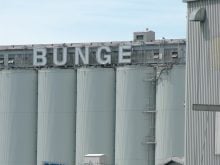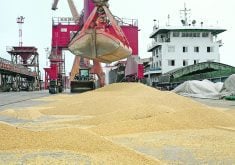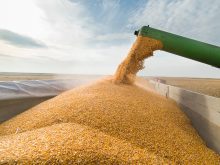This cattle market information is selected from the weekly report from Canfax, a division of the Canadian Cattlemen’s Association. More market information, analysis and statistics are available by becoming a Canfax subscriber by calling 403-275-5110 or at www.canfax.ca.
Fed market softens
The overall market tone was steady to softer last week as feedlots worked to slow seasonal easing in the fed market.
Alberta rail steer prices traded steady to $5 per hundredweight lower than the previous week, ranging from $388.50-$393.50 per cwt. f.o.b. the lot. Average rail steer prices are $2 per cwt. lower than the previous week. Last year, fed steer prices were in the middle of their price climb, though prices were largely steady through August. Heifer trade was slight.
Read Also

Flax sector sees omega-3 opportunity
SASKATOON — A global shortage of omega-3 oils could be an opportunity for the flax sector, says an industry official….
Two weeks ago, Canadian fed slaughter was 52,146 head, the second largest weekly fed volume since the end of March. Weekly western fed slaughter was 42,587 head, steady with the previous week. Western fed slaughter volumes remain seven percent below last year and are only two percent higher than the five-year average.
The five-year average shows that Alberta fed steer prices typically move mostly sideways right through to the end of September before rallying to end the year. Following historical trends may be a challenge this year. Poor packer margins will pressure feedlots.
In the United States, Nebraska saw trade at US$188 per cwt. live. Colorado reported trade at $188 per cwt. In Iowa, 1,500 head traded at $180-$190.50 per cwt. In Nebraska, 6,500 head traded at $188 per cwt. Sales were steady to $2 per cwt. stronger than the previous week.
For the week ending July 21, total slaughter was 625,915 head, 5.7 percent lower than the same week last year and 3.9 percent lower than the five-year average. Beef cow slaughter was 65,704 head.
Year-to-date fed slaughter is 3.3 percent lower than last year. Year-to-date heifer slaughter dipped 1.1 percent below year ago levels but is 6.5 percent higher than the five-year average. Total beef production is down 4.7 percent year to date.
Cow prices slide
Western Canadian packer interest has moderated, but feeder cow buyers continue to be active on the non-fed market. There has been a noticeable decline in cow volumes through commercial auction facilities over the past few weeks.
Butcher bull volumes have increased sharply. Some auction facilities reported 50 to 70 head of slaughter bulls at weekly sales.
Cow prices usually see a bit of a rally in early August, but that has not been the case this year. Cow prices were $2 per cwt. lower last week and have dropped $5 per cwt. over the past three weeks. D2s averaged $149.94 and D3s averaged $134.38 per cwt. There have been a few grain-fed cows at the market and premiums of roughly $5-$10 per cwt. were observed, compared to cows coming off grass.
Over the previous four weeks, western Canadian cow slaughter totalled more than 25,000 head. For July, this is the largest slaughter volume since 2009. Cow slaughter volumes usually bottom in August and increase through to November. In drier areas of Alberta, some community pastures may send cows home earlier than normal.
Active feeder market
Alberta 900 pound and heavier feeder prices have recently moved to a premium against the Ontario market.
There have been reports for the New Year that packers are offering fed basis contracts on either side of zero, suggesting these steers are being purchased $50-$75 per head offside. Closing over US$1 per cwt. higher on Aug. 11, the August 2024 live cattle contracts set new highs. With western Canadian feedlots booking a lot of U.S. corn for fall delivery and into the New Year, it is also important to highlight that since late July, the December corn contract has dropped more than 70 cents per bushel.
These two factors are supportive to the fall delivery calf market. This week, British Columbia, Alberta and Saskatchewan five-weight steer calves for October-November delivery traded from $362-$434 per cwt. with a weighted average price of $389.80 per cwt. based at 540 lb.
Forward delivery prices for fall look a little stronger compared to sales reported in July. For the first three weeks in July, Canadian feeder cattle exports to the U.S. totalled slightly more than 10,000 head, the largest for that period since 2015.
Dry conditions continue to be noted in B.C and larger auction volumes are running well above last year.
U.S. cutouts steady
In U.S. beef trade, Choice cutouts closed steady with last week at US$302.01 per cwt. Select cutouts were off slightly, down 0.5 percent to $278.31 per cwt.














